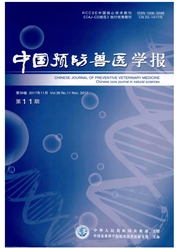

 中文摘要:
中文摘要:
本研究通过组织学和免疫组织化学方法,观察鸡新型肠相关性淋巴组织-食管扁桃体的组织结构特征。并研究其中T淋巴细胞及其亚群和抗体生成细胞的定位分布。研究发现,食管扁桃体的粘膜形成数目和结构与食管一致的皱襞,粘膜固有层中分布大量的淋巴组织,并存在于前胃腺;在隐窝固有层中,抗体生成细胞以IgM^+和IgA^+细胞为主,并主要分布在生发中心中,而CD3^+、CD4^+和CD8^+T淋巴细胞也有大量分布,主要存在于生发中心周围的滤泡间区域;在皱襞固有层中,各种淋巴细胞都分布在上皮下固有层中,数量明显少于隐窝固有层中的相应阳性细胞,抗体生成细胞以IgA^+细胞为主,T淋巴细胞则以CD3和CD4为主。研究表明:食管扁桃体位置特殊,将接触到大量的外界未消化抗原,并且它具有参与粘膜免疫的组织基础和细胞基础,此研究结果对食物过敏、免疫耐受和肠道感染的研究具有重要意义。
 英文摘要:
英文摘要:
The aim of this study was to investigate the histological characteristics of oesophageal tonsil in chicken, the localization and distribution of T lymphocytes or subpopulation, and antibody producing cells using immunohistochemistry. The results showed that the mucosa of oesophageal tonsil formed the same number and structure of folds with oesophagus. There was abundant lymphoid tissue and glandula paraventricularis in the lamina propria. The antibody producing cells was predominantly IgM^+ or IgA^+ cells in the germinal center of the lamina propria of crypt. There were a large number of CD3^+, CD4^+ and CD8^+ T lymphocytes in the interfollicular areas surrounding the germinal center. In the lamina propria of folds, lymphocytes mainly distributed under the epithelium and appeared less abundant. These results indicated that the esophageal tonsil may play an important role in food allergy, immune tolerance and intestinal infection.
 同期刊论文项目
同期刊论文项目
 同项目期刊论文
同项目期刊论文
 期刊信息
期刊信息
